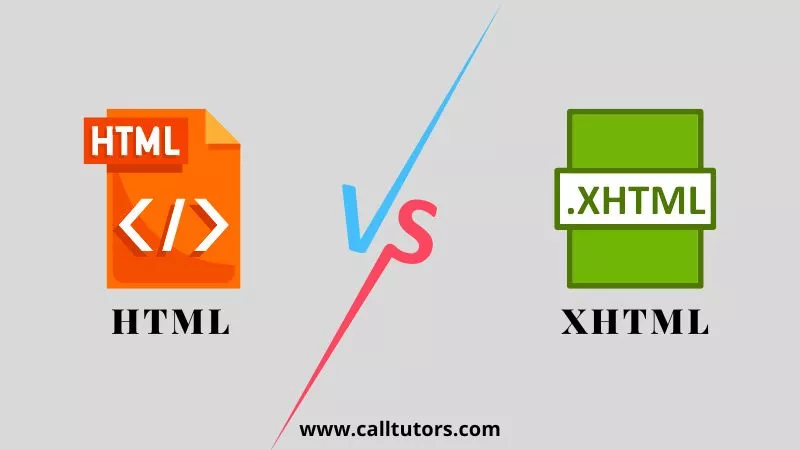Are you interested in knowing about some essential differences between HTML vs XHTML? If yes, then you came to the right place. We know that HTML vs XHTML is always a big concern among the students. Before going deeper, Let’s start with a short introduction to each of these terms.
Introduction To HTML
Table of Contents
HTML stands for Hyper Text Markup Language, and it is used to create web applications and web pages. Let’s see the meaning of Hypertext markup language and webpage.
HyperText: The term “hypertext” simply means “text within text.” A hypertext is a text that contains a link. When you click on that text that contains a link that takes you to a new webpage, it means you have clicked on a hypertext. HyperText is a method of connecting two or more web pages (HTML documents).
Markup language: A markup language is a computer language used to apply layout and the formatting conventions to the text documents. Markup language enhances the interactive and dynamic nature of text and also it can convert text into tables, images, links, and so on.
Web Page: A web page is a document and it is written in HTML and it is translated with the help of web browser. An URL can be used to locate a web page. A static or dynamic Web page can exist and we can create static web pages entirely with HTML.
Introduction To XHTML
XHTML is an abbreviation for EXtensible HyperText Markup Language. It is a cross between XML and HTML language.
XHTML language is nearly identical to HTML language, but it is stricter one than the HTML language. So, it is important that you create the code correctly as in case sensitivity and in syntax XHTML is stricter one that HTML.
XHTML is HTML that has been defined as an XML application and all the browsers that are major ones supports it. Unlike HTML, which requires a lenient HTML-specific parser, XHTML documents are well-formed and can be parsed using standard XML parsers.
HTML vs XHTML: The Essential Differences
Every web-based technology differs in some way from one another. Here are some key distinctions between these two markup languages that are shown below:
- For declaring the tags and elements, generally HTML followed the set of rules and in that rules will be accommodated with the root element behaviour and functions that are predefined. However, in XHTML, rules and regulations are some strict for assigning as well as for declaring the tags in HTML.
- HTML and XHTML both are the technologies that are web-based and can be used to write code on web pages. However, HTML is entirely based on the SGML (Standard Generalized Markup Language) language. And it also adheres to the DTD (document type definition) model, which is entirely based on the document structure rather than the characteristic features. It is confirmed with the html and xml standards that in the html, the xhtml is an xml-based feature. The codes will be more complicated than html, and it has assigned some strict rules to develop the web pages.
- When we use xhtml, it is created with some convoluted as well as reduced the tags that are browser-specific, whereas in html codes, the tags and elements may vary depending on the browsers of the user. We already know that xml is a markup language, and we’ve all used it in web page requests and server responses. It contains some patterns as well as well-formed documents. For describing the web data that we have written in the web document we can use xml but we use html to display the data in web browsers that we have designed and documented in the web document.
- Xhtml web pages are used to read all devices that are xml supported and are also included with browsers that support the xml language. The xhtml elements will be used correctly when nested with the other elements that are supported. It follows the same basic rule as the opening and closing tag system xhtml tag elements, which are always written in lower case letters, and it must have one root element. The names of the attribute must be in lowercase letters, and values must be quoted, and xhtml supports dtd type documents for mandatory elements.
HTML vs XHTML: In Tabular Form
The table below is a comparison table of HTML vs XHTML
| Basis Of Comparison | HTML | XHTML |
| Stands For | HTML stands for Hypertext Markup Language. | HTML stands for Extensible Hypertext Markup Language. |
| Developed In | In 1987 Tim Berners-Lee proposed it. | In 2000, the World Wide Web Consortium recommended it. |
| Filename Extension | .html, .htm | .htm, .xht, .xml, .html, .xhtml |
| Application | It is an SGML application. | It is an XML application. |
| Case Sensitivity | It is not case sensitive. | It is case sensitive. |
| Format Type | It uses the format which one is similar to document formats. | It uses the markup language. |
| Expressiveness | It is less expressive. | It is more expressive. |
| Attribute Values | In HTML, attribute values are not significant. | In XHTML, attribute values are important. |
| Elements Structure | The structure of the elements has no hard rules. | The elements’ structure should be followed. |
| Tags | It can use the open tags like <br> | In XHTML, all unclosed tags must be closed. |
| Root Element | It is not mandatory for a single root element. | Documents of XHTML must have atleast one root element. |
| Versions | HTML 2, HTML 3.2, HTML 4.0, HTML 5. | XHTML 1, XHTML 1.1, XHTML 2, XHTML 5. |
| Nature | It requires a lenient HTML-specific parser. | It needs to be parse with XML parser that is standard one. |
Conclusion (HTML vs XHTML)
In this blog, we have discussed HTML vs XHTML. And, for the students to understand the differences that are essential ones in between the terms HTML vs XHTML is very helpful. But if in any case, you need assistance regarding HTML Assignment Help then feel free to contact us. We are always available to help you.
FAQ’s Related To HTML vs XHTML
Is XML and XHTML same?
XHTML is an HTML-based standard that has been tweaked to comply with XML’s stricter rules. An XHTML document is also an XML document, and it can be parsed by any XML parser if it’s written correctly.
Is HTML5 a XHTML?
HTML5 is an HTML version, whereas XHTML is a combination of HTML and XML. XHTML has its own parsing requirements, whereas HTML doesn’t have any requirements and uses its own.




